Cross-Century Worldviews
At the end of chapter 1 we contemplated the staggering diversity of the world’s languages, core beliefs, entrenched views, and cultural behavior. Our hunter-gatherer forebears probably had simpler goals and philosophies. Recorded history over the last five millennia indicates that the more civilizations come into contact, the more they seem to clash. The two world wars have been daunting both in scope and complexity.
If we regard the wars in Korea, Vietnam, Iran, Iraq, Kuwait, Yugoslavia, and Afghanistan as local conflagrations, we could claim the world has enjoyed relative peace since 1945. This peace is indeed very relative because many lives have been lost and untold billions of dollars have been spent on armaments in this period, but at least the major powers—the United States, Russia, Britain, France, Germany, and China—have so far avoided any depth of involvement in hostilities that would have necessitated nuclear strikes and subsequent global chaos. Japan—still non- nuclear—has kept its head down.
In this same period, politico-economic associations such as the EU, NAFTA, ASEAN and MERCOSUR have been formed with the objective of facilitating interregional and world trade via an increase in international cooperation and understanding. At the beginning of the twenty-first century, we consider ourselves rational, knowledgeable, and possessing a high degree of technology and scientific insight. In theory we should have attained a level of comprehension and perception that would enable us as citizens of the world to settle for a quasi-universal worldview and consign cultural dissension to the dustbin of history.
Unfortunately, we have not yet come so far. We can bear witness to real progress in certain areas. France and Germany seem to have put an end to their traditional hostility; they trade with each other vigorously. In spite of frequent niggling, the United States and Japan have set up bilateral trade of a magnitude the world has never seen. Chinese and Korean goods are ubiquitous in both Europe and the U.S., and the success stories of Singapore, Hong Kong, and Taiwan have shown that vigorous exports pave the way to prosperity.
When trade and employment flourish, cultural problems take a back seat. In times of recessions—and these occur with annoying regularity—friction develops between states with opposing philosophies. Lack of understanding leads to breakdowns of communication, application of sanctions, and threats of isolationist policies. These crises may be exacerbated by political motives, but often cultural differences are the root of the problem. Countries belonging to the same cultural category, for instance, Nordics on the one hand or Italians and Spaniards on the other, rarely fail to sort out their differences in terms of trade and cooperation.
At cross-century we have a situation where there are many nation-states and different cultures but where enduring misunderstandings arise principally when there is a clash of category rather than nationality. For example, Germany and the Netherlands experience national friction, but they understand and cooperate with each other well because they are both linear-active (see later in this chapter for a definition). Friction between Korea and Japan occasionally borders on hatred, but their common reactive nature leads to blossoming bilateral trade.
Let us examine for a moment the number and variety of cultures as they now stand and consider how classification and adaptation might guide us toward better understanding.
The Categorization of Cultures
There are over two hundred recognized countries or nation-states in the world; the number of cultures is considerably greater on account of strong regional variations. For instance, marked differences in values and behavior are observable in the north and south of such countries as Italy, France, and Germany, while other states are formed of groups with clearly different historical or ethnic backgrounds (the United Kingdom with its Celtic and Saxon components, Fiji’s Polynesians and Indians, and Russia’s numerous subcultures such as Tatar, Finnic, Chechen, etc.)
In a world of rapidly globalizing business, electronic proximity, and political-economic associations, the ability to interact successfully with foreign partners in the spheres of commercial activity, diplomatic intercourse, and scientific interchange is seen as increasingly essential and desirable. Cross-cultural training followed by international experience goes a long way toward facilitating better relationships and reducing misunderstanding. Ideally, the trainee acquires deepening insight into the target (partner’s) culture and adopts a cultural stance toward the part- ner/colleague, designed (through adaptation) to fit suitably with the attitudes of the other.
The question then arises as to how many adaptations or stances are required for international interaction. Not even the most informed and adaptable executive or professional could envisage assuming two hundred different personalities! Even handling the fifteen different national types on EU committees and working groups has proved a daunting task for European delegates, not to mention the chairpersons.
Such chameleon-like behavior is out of the question, but the question of adaptation remains nevertheless important. The reticent, factual Finn must grope toward a modus operandi with the loquacious, emotional Italian. Americans will turn over many more billions in trade if they learn to communicate effectively with the Japanese and Chinese.
Assuming a suitable cultural stance would be quickly simplified if there were fewer cultural types to familiarize oneself with, is it possible to boil down 200 to 250 sets of behavior to 50 or 20 or 10 or even half a dozen? Cross-culturalists have grappled with this problem over several decades. Some have looked at geographical divisions (north, south, east, and west) but what is “eastern” culture? And is it really unified? People can be classified according to their religion (Muslim, Christian, Hindu) or race (Cauca- sian, Asian, African, Polynesian, Indian, Eskimo, Arab), but such nomenclature contains many inconsistencies—Christian Norwegians and Lebanese, Caucasian Scots and Georgians, Muslim Moroccans and Indonesians, and so on. Other classification attempts such as professional, corporate, or regional have too many subcategories to be useful. Generational culture is important but ever-changing. Political classification (left, right, centrist) has many (changeable) hues, too.
Writers such as Geert Hofstede have sought dimensions to cover all cultures. His four dimensions included power distance, collectivism/individualism, femininity/masculinity, and uncertainty avoidance. Later he added a fifth dimension, long-term/short-term orientation. Edward T. Hall classified groups as monochronic or polychronic, high or low context, and past- or future-oriented. Fons Trompenaars’ dimensions were different still: universalist/ particularist, individualist/collectivist, specific/diffuse, achievement-/ascription-oriented and neutral/emotional or affective. The German sociologist Ferdinand Tnnies identified gemeinschaft and gesellschaft cultures. Florence Kluckhohn’s five categories were in the form of solutions to problems: time, person-nature, human nature, form of activity, and relation to one’s cultural compatriots. Samuel Huntington drew fault lines between civilizations—West European, Islam, Hindu, Orthodox, Japanese, Sinic, and African.
The need for a convincing categorization is obvious. It enables us to
- predict behavior,
- clarify why people do what they do,
- avoid giving offense,
- search for some kind of unity,
- standardize policies, and
- perceive neatness and Ordnung (order).
My own research and experience has led me to believe in a three- category classification of cultures: linear-active, multi-active, and reactive. My extensive exposure to Asians inclined me to think that European and American cross-culturalists had failed to categorize them succinctly. Japanese are not polychronic (like Italians), but neither are they monochronic (like Germans). While Koreans are clearly particularist, the Chinese are much less so, but neither are they universalist. Japan is high context, but Indonesians and Vietnamese border on low context. Short-term and long-term orientation varies enormously between Korea and the Philippines on the one hand and Japan and China on the other.
[1] For a chart distinguishing linear-active, multi-active, and reactive cultural attributes, see Appendix A, pages 295–97.
Most Asians (with the notable exception of the Indians and Pakistanis) classify as reactive inasmuch as they will veer toward linear- or multi-activity within the framework of their reaction to their interlocutor. Thus Japanese stress their qualities of punctuality, factuality, and planning when dealing with Germans but adopt a more flexible, people-oriented approach when confronted with multi-active Spaniards or Latin Americans.
The linear-active, multi-active, and reactive categorization cuts across racial, religious, philosophical, and class divides. Protestant Scandinavians, Catholic Swiss, black and white Americans, Semitic Israelis, and rich and poor Australians are all linear as a whole. Multi-actives can be Latins, Slavs, or Africans. Chinese, Koreans, and Vietnamese are classical Confucian reactives, but quiet Finns also have many reactive characteristics, and Swedes and the British often react thoughtfully and unhurriedly to proposals from more aggressive cultures.
The diagram on page 75 summarizes the essential characteristics of each group and indicates different degrees of difficulty typically encountered when they interact with each other.
Linear Actives
Linear-active people tend to be task-oriented, highly organized planners who complete action chains by doing one thing at a time, preferably in accordance with a linear agenda. They prefer straightforward and direct discussion, depending on facts and figures they obtain from reliable, often printed or computer-based sources. Speech is for information exchange, and conversationalists take turns talking and listening. Truthful rather than diplomatic, linear- actives do not fear confrontation, adhering to logic rather than emotions. They partly conceal feelings and value a certain amount of privacy. Results are key, as is moving forward quickly and compromising when necessary to achieve a deal.
Linear-actives believe that good products make their own way and sometimes fail to see that sales are based on relationships in many parts of the world. They normally use official channels to pursue their aims and are usually not inclined to use connections, take shortcuts, or influence opinions through presents or under- cover payments. Normally law-abiding, linear-actives have faith in rules and regulations to guide their conduct.
They honor written contracts and do not unduly delay payment for goods or services received. When doing business, they are keen on punctual performance, quality, and reliable delivery dates. Maana behavior and overloquacity are frowned upon. They are process oriented, brief on the telephone, and respond quickly to written communication. Status is gained through achievement, bosses are often low-key, and money is important. Rationalism and science dominate thinking more than religion does.
Multi Actives
Multi-actives are emotional, loquacious, and impulsive people; they attach great importance to family, feelings, relationships, and people in general. They set great store by compassion and human warmth. They like to do many things at the same time and are poor followers of agendas. Conversation is roundabout and animated as everyone tries to speak and listen at the same time. Not surprisingly, interruptions are frequent, pauses in conversation few. Multi-actives are uncomfortable with silence and can seldom tolerate it.
In business, relationships and connections are seen as more important than products. The former pave the way for the sale of the latter. Relationships are best when they are face-to-face; they cannot be maintained over a protracted period simply by written correspondence or phone calls, although the former has less effect with multi-actives than the latter. They much prefer to obtain their information directly from people and trade in rumor and gossip. Multi-actives show less respect than linear-actives do for official announcements, rules, or regulations. Although they have limited respect for authority in general, they nevertheless accept their place in their own social or company hierarchy. Strong bosses are admired and are also expected to protect their employees.
Multi-actives are often late with delivery dates and paying for services or goods received. Less interested in schedules or deadlines than linear-actives are, multi-actives often move only when they are ready. Therefore, procrastination is common, punctuality infrequent. Multi-actives’ concepts of time and discourse are decidedly nonlinear, and they fail to understand the importance that timetables have for linear-active people.
Multi-actives are flexible and frequently change their plans, which in themselves are not as detailed as those of linear-actives. Improvisation and handling chaos are strong points.
Multi-actives borrow and lend property rather freely. They are gregarious and inquisitive, valuing privacy less than company. Often epicurean, they adhere less to strict Protestant values than linear-actives do. In business, they use charisma, rhetoric, manipulation, and negotiated truth. They are diplomatic and tactful and often circumvent laws and officialdom to take “shortcuts.” They entertain lavishly and give presents or undercover payments to secure deals and contracts.
Reactives
Reactives, or listeners, rarely initiate action or discussion, preferring to first listen to and establish the other’s position, then react to it and formulate their own opinion.
Reactives listen before they leap, concentrating on what the speaker is saying and refusing to let their minds wander (difficult for Latins). Rarely, if ever, do they interrupt a speaker during a discourse/speech/presentation. When the speaker is finished, they do not reply immediately but rather leave a decent period of silence after the speaker has stopped in order to show respect for the weight of the remarks, which must be considered unhurriedly and with due deference.
Even when representatives of a reactive culture begin their reply, they are unlikely to voice any strong opinion immediately. A more probable tactic is to ask further questions on what has been said in order to clarify the speaker’s intent and aspirations. The Japanese, particularly, go over each point in detail many times to make sure there are no misunderstandings. The Chinese take their time to assemble a variety of strategies to avoid discord with the initial proposal.
Reactives are introverts, distrustful of a surfeit of words and consequently are adept at nonverbal communication, which is achieved by subtle body language. Reactions are worlds apart from the excitable gestures of Latins and Africans.
In reactive cultures the preferred mode of communication is monologue-pause-reflection-monologue. If possible, one lets the other side deliver his or her monologue first. In linear-active and multi-active cultures, the communication mode is a dialogue. The person speaking may be interrupted by frequent comments, even questions, which signify polite interest in what is being said. As soon as the speaker pauses, someone else takes his or her turn immediately. Many Westerners have an extremely weak tolerance for silence.
Reactives not only tolerate silence well but regard it as a very meaningful, almost refined, part of discourse. The opinions of the other party are not to be taken lightly, or dismissed with a snappy or flippant retort. Clever, well-formulated arguments require—deserve—lengthy silent consideration. The American, having delivered a sales pitch, leans forward and says, “Well, what do you think?” If a reactive is asked for an opinion, he or she begins to think—in silence.
The reactive “reply-monologue” is context-centered and will presume a considerable amount of knowledge on the part of the listener (who, after all, probably spoke first). Because the listener is presumed to be knowledgeable, Japanese, Chinese, or Finnish interlocutors will often be satisfied with expressing their thoughts in half-utterances, indicating that the listener can fill in the rest. It is a kind of compliment.
Reactives not only rely on utterances and partial statements to further the conversation, but they also indulge in other habits that confuse the linear-active or multi-active. They use, for instance, a “roundabout” style, with impersonal verbs (one is leaving) or the passive voice (one of the machines seems to have been tampered with), either to deflect blame or with the general aim of politeness.
As reactive cultures tend to use names less frequently than multi-active or linear-active ones do, the impersonal, vague nature of the discussion is further accentuated. Lack of eye contact, so typical of the reactive, does not help the situation. A Finn or a Japanese, embarrassed by another’s stare, seeks eye contact only at the beginning of the discussion or when he wishes to signal the interlocutor to take up her turn in the conversation.
Smalltalk does not come easily to reactives. While the Japanese and Chinese trot out well-tried formalisms to indicate courtesy, they tend to regard questions such as “Well, how goes it?” as a literal request for information and may take the opportunity to voice a complaint. On other occasions their overlong pauses or slow visible reactions cause nonreactives to think they are slow- witted or have nothing to say.
It is always important to bear in mind that the actual content of the response delivered by a reactive represents only a small part of the significance surrounding the event. Context-centered utterances inevitably attach less importance to what is said than to how something is said, who said it, and what is behind what is said. What is not said may be the main thrust of the reply.
Self-disparagement is another tactic of reactives; it eliminates the possibility of offending others. Such humility may draw the other person into praising one’s conduct or decisions. Linear- actives and multi-actives must be aware of presuming that self- disparagement is connected with a weak position.
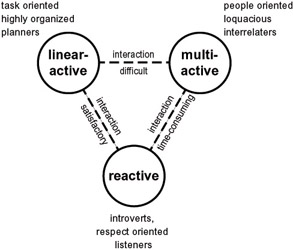
Cultural Categories
Intercategory Comparisons
Common linear-active behavior will facilitate smooth relations between, for instance, Swedes and Flemish Belgians. Likewise, a common multi-active mentality will help Italians, Argentinians, and Brazilians interact successfully. In the Vietnam War, the most popular foreign troops with the South Vietnamese were reactive Koreans. The groups shared naturally underlying similarities because they both belonged to the same cultural category.
When members of different cultural categories begin to inter- act, the differences far outnumber the commonalities. The diagrams on pages 77–78 illustrate intercategory relationships. When we look carefully at these diagrams, we can see that commonalities exist among all three types, but similarities are fewest between linear-actives and multi-actives. Reactives fit better with the other two because they react. Consequently, the trade-hungry Japanese settle comfortably in conservative, orderly Britain and also have reasonably few problems adapting to excitable Latins on account of their similar orientation toward people, diplomatic communication, and power distance.
The entirely disparate worldviews of linear-actives and multi- actives pose a problem of great magnitude as we begin a new century of international trade and aspire to globalization. How can the pedantic, linear German and the voluble, exuberant Brazilian share similar views of, for instance, duty, commitments, or personnel policies? How can the French reconcile their sense of intellectual superiority with cold Swedish logic or the American bottom-line mindset? Will Anglo-Saxon hiring and firing procedures ever gain acceptability in people-oriented, multi-active Spain, Portugal, or Argentina? When will product-oriented Americans, Britons, and Germans come to the realization that products make their own way only in linear-active societies but that relationships pave the way for product penetration in multi-active cultures? One can well say, “Let’s concentrate on selling to the six hundred million linear-active customers in the world.” But what about multi-active and reactive customers? The fact is, there are a lot of them: three and a half billion multi-active and just under two billion reactive customers at last count. The chart below shows predicted numbers in each category for the year 2005.

Linear-Active and Multi-Active Comparison
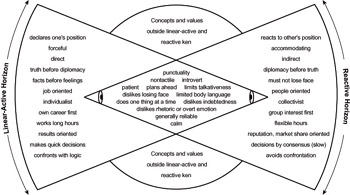
Linear-Active and Reactive Comparison
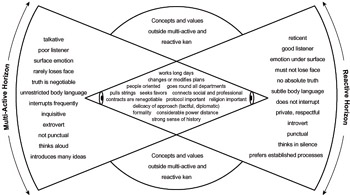
Multi-Active and Reactive Comparison
The figures on pages 80–82 summarize the salient characteristics of the three cultural categories. Figures A, B, and C elaborate on the values and communication styles in the linear world, multi- world, and reactive world respectively. Figure D, page 83, indicates that while some countries are convincingly linear-active (Germany), multi-active (Argentina, Brazil), or reactive (Vietnam), others are more hybrid, combining traits from two or even three categories.
|
Linear-active: 600 million Multi-active: 3,500 billion Reactive: 1,800 billion Hybrid (multi-active and reactive): Indonesia: 220 million Philippines: 80 million TOTAL: 6,200 million |
A discernible thread of extraneous influences has begun to weave itself into the area of international business. For instance, the successful Japanese, with their logical manufacturing processes and considerable financial acumen, are becoming more amenable to Western linear thinking. Hong Kong was created to make money, a very linear and countable commodity, while Lee Kuan Yew’s brilliant economic management of Singapore—the result of combining his innate Confucianism with his double first degree from Cambridge—pushed that tiny island city-state to the very borders of linear-activity, in spite of its 72 percent Chinese majority population.
Other East Asian reactive nations tend to temper their inherent reactivity by occasionally wandering along the reactive/multiactive plane. The Chinese are less interested in Western linear thinking and logic (“There is no absolute truth”) than in mammoth gut feeling and periodic explosive assertion of their inalienable rights and dominance based on a culture that is five thousand years old. They have no interest whatsoever in Western logic as applied to Tibet, Taiwan, or human rights. Koreans, while extremely correct in their surface courtesy, actually suppress seething multi-active emotion, even tendencies to violence, more than any other Asians. They frequently demonstrate explosive rage or unreliability vis--vis foreign partners or among themselves. Further along this plane, Indonesians and Filipinos, after many centuries of colonization, have developed into cultural hybrids, sometimes opposing, sometimes endorsing the policies and cultural styles of their former colonizers.
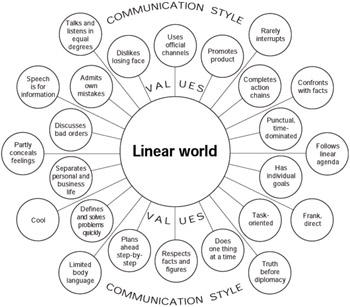
Figure A: The Linear World
Near the end of the multi-active plane, we encounter populations whose characteristics, though differing significantly in terms of historical background, religion, and basic mindset, resemble each other considerably in the shape of outstanding traits, needs, and aspirations. For example, Latin Americans, Arabs, and Africans are multi-active in the extreme. They are excitable, emotional, very human, mostly nonaffluent, and often suffer from previous economic exploitation or cultural larceny. Turkey and Iran, with more Eastern culture intact, are somewhat better off economically, although all of this group needs either aid, debt forgiveness, better trade conditions, more medical help, or more education—or, in the case of African countries, all of the above.
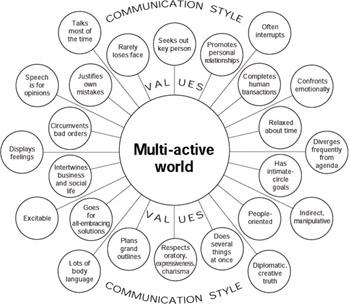
Figure B: The Multi-Active World
What all of these groups could benefit from, at little or no cost to affluent nations, would be compassion, understanding, cooperation, and linkages where possible as well as recognition of achievement and progress.
To switch our commentary to Northern European cultures, and proceeding along the linear-active/reactive axis, let’s consider three committedly linear countries that exhibit reactive tendencies (when compared with the Germanics): Britain, Sweden, and Finland. British individuals often seek agreement among colleagues before taking decisive action. Swedes are even further along the reactive line, seeking unanimity if possible. Finns, however, are the most reactive of Europeans in that their firm decision-making stance is strongly offset by their soft, diffident, Asian communication style (plenty of silence) and their uncanny ability to listen at great length without interrupting.

Figure C: The Reactive World
The linear-active/multi-active axis is fairly straightforward. The United States, Norway, and the Netherlands plan their lives along agenda-like lines. Australia has multi-active flashes due to substantial immigration from Italy, Greece, and former Yugoslavia. Danes, though linear, are often referred to as the “Nordic Latins.” France is the most linear of the Latins, Italy and Spain the least. Russia, with its inherited Slavic soul, classifies as a loquacious multi-active, but slots in a little higher on the linear-active side on account of its many millions living in severely cold environments. Belgium, India, and Canada occupy median positions on their respective axes. These positions can be seen as positive and productive. Belgium runs a highly prosperous and democratic economy by finding a successful compromise between linear- active (Flemish) and multi-active (Walloon) administrations. Canada, because of massive immigration and intelligent government cultural care, is the most multicultural country in the world. Indians, though natural orators and communicators, have combined these natural skills and warmth with Eastern wisdom and courtesy. On top of that they have inherited a considerable number of British institutions, which enables them to relate to the West, too.

Figure D: Cultural Categorization

Figure E: Hybrid Types
Figure E shows how certain nationalities sharing characteristics from two categories may find areas of cooperation or common conduct. Those close to the linear-reactive axis are likely to be strong, silent types who can work together calmly and tend to shun multi-active extroversion and loquacity. Those close to the multi-active/reactive axis will, in spite of visible differences, attach great importance to relationships and circumvent official channels by using personal contacts or networks. People close to the linear-active/multi-active axis, though opposites in many ways, are inevitably broad-minded on account of their range of traits and are likely to be forceful and persistent in their actions.
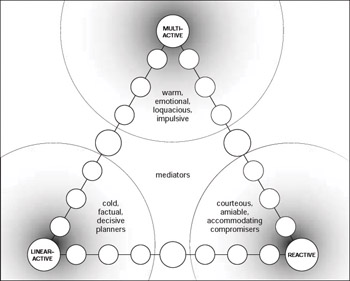
Figure F: Style Variation
Figure F suggests that individuals whose cultural profiles wander away from the axes and who occupy a central classification inside the triangle may possess qualities that enable them to be efficient mediators or team leaders.
Case Study: The Mexican Mindset
The Mexican psyche, even before the United States ascended to dominance, was already profoundly different from that of other European- or Asian-influenced cultures on account of the dramatic and irreversible fusion of Indian and Latin characteristics in the years following Hernn Corts’ victory in 1521. Mexicans, like other Latin Americans, derive many of their characteristics from Spain, whose language, religion, values, and lifestyle were imported by the conquistadores. The subsequent fusion of cultures was, however, quite different in Mexico from what occurred in the United States, Brazil, or Argentina, where the indigenous peoples were decimated, marginalized, or ignored culturally.
When Corts arrived in Mexico, a magnificent civilization was already in place. It is true that the Aztec armies were defeated and the populations subjugated, but the indigenous influence remained, pervading every aspect of Mexican life: food, involvement with nature, beliefs, concepts of time and space, attitudes toward authority, and eventually the Mexican worldview itself. The readiness of the Spaniards to intermarry with Indians soon produced a rapidly expanding mestizo population and culture which gave Mexico the most Indian-oriented mindset among the major American countries.
Which are the Indian-influenced characteristics of the Mexican? If passion, rhetoric, exuberance, extroversion, and imagination are Hispanic traits, the subtler, deeper, more inscrutable side of the Mexican reveals an affinity with indigenous life. Though normally bouncy and gregarious, Mexicans frequently slip into melancholy and despairing moods, where fatalism, apathy, and a sense of powerlessness combine to produce an inferiority complex far removed from Argentinian conceit or Brazilian gay abandon. At such times Mexicans “put on a mask,” concealing their feelings behind an impassive countenance denoting stoicism in adversity and a quiet understanding of human suffering. From the Indians Mexicans have also inherited the passive acceptance of the stratification of society, just as it was in the Aztec caste system: a readiness to assume a preordained role in the hierarchy, an exaggerated deference for age and its assumed wisdom, and an ability to face poverty, hardship, and death itself without undue fuss or complaint. This is a product of the Indian concept of cyclical time, presupposing that compensation is achieved when the wheel turns full circle and that no human endeavor, however strenuous, can really affect the immediate sequence of events.
Like the Indians, the Mexican believes in the solidity and comforting support of the group, where oral agreements are kept, commitments are honored, and trustworthiness is paramount. These time-honored values dominate Mexican business and social life today. Indigenous peoples, who mixed the natural and supernatural in their everyday life, lost face if they could not find sufficient sacrifices for their demanding gods. The modern Mexican is similarly preoccupied with face and credibility, far more than most Latin Americans, who are often more pragmatic. “La dignidad del hombre” (“The dignity of the man”), certainly a Spanish concept, is a more sensitive issue in Mexico than anywhere in Europe, with the possible exception of Sicily.
Mexican face-saving and the obsession with respect and status resemble the Asian (Japanese) variety in its finickiness and intensity. This Asian characteristic was carried over the Bering Strait by the native populations and has lost no significance in the cultures they affected, all the way from Alaska to Tierra del Fuego. The Asian-Indian influence is also seen in the slow Mexican tempo in building relationships, the Mexicans’ unwillingness to commit themselves to involvement with others if trust has not been established, suspicion of the “gringo” (how often the Indians were betrayed!), and the tendency to look for a go-between if agreement cannot be reached in discussion. Above all the Mexican mestizos are united with their Indian forebears by a sense of historical perspective and a conviction that anything that happens in the present is an inevitable result of past action and destiny. Logical thinking therefore differs sharply from the linear Western model.
If we compare Mexican cognition of the hierarchical group with the Asian view, it involves a need for completeness, which is not altogether dissimilar from the Chinese. The Mexican leader may have acquired his position initially by birthright or nepotism, but he will not be successful unless he takes great pains to develop a huge network of friends, business partners, and officials who will help him to consolidate his power base. As in the Aztec cacique system, these relationships are built on complex personal ties that allow favors to be sought, usually granted, and ultimately reciprocated.
In business a senior manager will command unquestioned obedience and respect from subordinates, but as in Confucian systems, he is obliged to reward them with loyalty, courtesy, and protection. The patrn wields his power openly and with machismo, but he will show immediate compassion for a worker’s misfortunes and come readily to the aid of the worker’s family in the case of undue hardship or bereavement. The patrn is himself a family man, a good Catholic and moralist as well as a shrewd tactician and negotiator. When the chips are down, he has the connections and levers of power to attain the goals of the group he leads. This is what the Mexicans mean by completeness: the cycle of reciprocity whereby the patrn exchanges protection for loyalty and respect. Subordinates will therefore not reason in any individual manner. Abstract principles count little (or not at all) with Mexicans if they contradict or clash with the views of one of their leaders.
Mexicans’ cognition of time is part multi-active and part reactive. This differs sharply from linear time. Much has been written about the Hispanic maana syndrome, which, though perhaps originating in Moorish Andaluca, is associated more closely with Mexico than with any other nation. The slow, deliberate lifestyle of the Indians hardly mitigated this tendency. Punctuality at events is not high on the list of Mexican priorities. In most hierarchical societies, the powerful make others wait, and this is considered acceptable practice. Easy access to a superior casts doubt on his status.
In Mexico life is not organized around the clock—a mere machine—but around a succession of encounters and relationships that are qualified and quantified not in linear fashion but in terms of depth of personal involvement, excitement, opportunity, or caprice. Human transactions must be satisfactorily completed, not interrupted by the ringing of a bell or a knock on the door. This is one aspect of time—the relationship takes precedence over the schedule. Another aspect, which concerns late deliveries or tardy payments, often accompanied by a paucity of communication, is an un-ending source of irritation to linear-active, to-the-point Americans, Germans, and others, who accuse Mexicans and Spaniards of laziness. But Mexicans and Spaniards are not lazy—they cannot afford to be! Delays may be caused by the necessity to juggle options or assets due to a lack of resources, or simply because one is not ready to make one’s move yet. Cheated so often in the past, the Mexican has good reason to move slowly! Mexicans recognize that fate has many things in store for us that we cannot foresee, that the sequence of events in God’s calendar may not correspond to man-made schedules and deadlines. Sometimes one has to make changes in one arena to accommodate changes elsewhere. One has to choose one’s priorities. When invited to two parties on the same evening, the Scandinavian or the American will politely reject the less attractive option or the second invitation received. The Mexican, doubly honored, will please both hosts by attending the two parties, but he can hardly be punctual at both!
Preface
- From 2,000,000 B.C. to A.D.2000: The Roots and Routes of Culture
- Culture and Climate
- Culture and Religion
- Cross-Century Worldviews
- Cultural Spectacles
- Cultural Black Holes
- Cognitive Processes
- The Pacific Rim: The Fourth Cultural Ecology
- The China Phenomenon
- Americanization versus Asianization
- Culture and Globalization
- Empires Past, Present, and Future
Conclusion
EAN: 2147483647
Pages: 108
